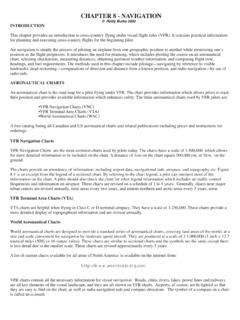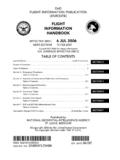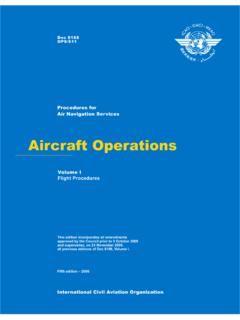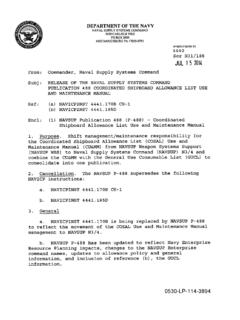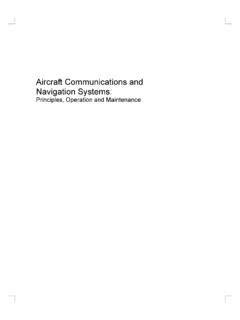Transcription of CHAPTER 7 - CANADIAN AIRSPACE - AeroTransport
1 CHAPTER 7 - CANADIAN AIRSPACE INTRODUCTIONThis CHAPTER introduces the various classifications of AIRSPACE and provides information on the requirements to operate in such AIRSPACE . Further information can be found in the Aeronautical Information Publication (AIP). CANADIAN Domestic AIRSPACE is divided into two areas: the Northern Domestic AIRSPACE , and the Southern Domestic AIRSPACE . Reilly Burke 2005 Most of the AIRSPACE north of the lower provinces is Northern Domestic AIRSPACE ; this is particularly difficult AIRSPACE for conventional navigation for three reasons:(a) it is much colder than the temperate lower regions, (b) magnetic directions are more difficult to determine, and(c) the area is sparsely settled and communication with ATS is very difficult.
2 Reilly Burke 2005 Fig 7-1 CANADIAN Domestic AirspaceTrue North Pole27 WO20 E OenSouthr Dmcoesti aeAirspcorn NtherDoestc mirpeAisacMnageticoVariatinMagnetic North Pole atpoontoTrWithin the Northern Domestic AIRSPACE , navigation, runway numbering, and wind direction are based on TRUE track; in Southern Domestic AIRSPACE these are based on the MAGNETIC track. Fig 1 shows the large discrepancy between Magnetic North (shown on your compass) and True North (the axis of rotation of planet , altimeter settings in the north, within what is called the Standard Pressure Region, are based on a standard value of , whereas in the southern region (the Altimeter Setting Region) altimeters are set according to the local barometric pressure.)
3 CANADIAN AIRSPACE is bounded by Air Defence Identification Zones which are shared with the USA. Within the two major AIRSPACE areas there are four types of AIRSPACE : controlled, uncontrolled, special use, and other 7-2 presents a profile view of the dimensions of various classes of AIRSPACE . Figure 7-3 gives the basic weather minimums for operating in the different classes of AIRSPACE . Figure 7-4 lists the operational and equipment requirements. It will be helpful to refer to these figures as this CHAPTER is studied. Also there are excerpts from Visual Navigation Charts in CHAPTER 8, Navigation, that will show how AIRSPACE is AIRSPACEC ontrolled AIRSPACE is a generic term that covers the different classifications of AIRSPACE and defined dimensions within which air traffic control service is provided in accordance with the AIRSPACE classification.
4 Controlled AIRSPACE consists of:Class AClass BClass CClass DClass EClass FClass G Fig 7-2 CANADIAN AIRSPACE StructureClass A airspaceClass A AIRSPACE is designated where an operational need exists to exclude VFR aircraft. This is the AIRSPACE where large airliners operate. This is the territory of strong pressurization and jet engines since piston engines can't produce the required power in this thin atmosphere. Very few light aircraft are capable of operating in the thin, cold air of Class A operations must be conducted under Instrument Flight Rules and are subject to ATC clearances and instructions. ATC separation is provided to all aircraft operating in Class A AIRSPACE must be equipped with a transponder and automatic pressure altitude reporting A AIRSPACE will be designated from the base of all high level controlled AIRSPACE (18,000'ASL) up to and including B airspaceClass B AIRSPACE is designated where an operational need exists to provide air traffic control service to IFR aircraft and to control VFR aircraft.
5 All low level controlled AIRSPACE above 12 500 feet ASL or at and above the MEA, whichever is higher, up to but not including 18 000 feet ASL will be Class B AIRSPACE . Light pressurization or oxygen is required, and piston engines will need to be turbocharged. This is where most commuter-type aircraft operate. Operations may be conducted under IFR or VFR. All aircraft are subject to ATC clearances and instructions. ATC separation is provided to all zones and associated terminal control areas may also be classified as Class B AIRSPACE . In the USA, Class B AIRSPACE is the AIRSPACE around the largest airports. This is the major difference between CANADIAN & US : 1: No person shall operate an aircraft in Class B controlled AIRSPACE in VFR flight unless:(a)the aircraft is equipped with:1.
6 Radio communication equipment capable of two-way communication with the appropriate ATS facility, and2. radio navigation equipment capable of using navigation facilities to enable the aircraft to be operated in accordance with the flight plan, transponder and automatic pressure altitude reporting equipment;(b) a continuous listening watch is maintained by a flight crew member on a radio frequency assigned by ATC;(c) except as otherwise authorized by ATC, when the aircraft is over a reporting point a position report is transmitted to the appropriate unit or, when so directed by ATC, to an FSS; and(d) the aircraft is operated in VMC at all : A person operating an aircraft on a VFR flight in Class B AIRSPACE shall operate the aircraft in VMC at all times.
7 When it becomes evident that flight in VMC will not be possible at the altitude or along the route specified, the pilot shall: (a)request an ATC clearance which will enable the aircraft to be operated in VMC to the filed destination, or to another aerodrome;(b)where the person is the holder of a valid instrument rating, request an IFR clearance for flight under the instrument flight rules; or(c)where the Class B AIRSPACE is a control zone, request an authorization for special VFR flight,3: A person operating an aircraft in Class B controlled AIRSPACE in VFR flight who is unable to comply with the requirements of the preceding paragraphs shall ensure that:(a) the aircraft is operated in VMC at all times;(b) the aircraft leaves Class B controlled AIRSPACE :1.
8 By the safest and shortest route, either exiting horizontally or descending, or2. when that AIRSPACE is a control zone, by landing at the aerodrome on which the control zone is based, and(c) an ATC unit is informed as soon as possible of the actions taken pursuant to paragraph (b).Class C airspaceClass C AIRSPACE is a controlled AIRSPACE within which both IFR and VFR flights are permitted, but VFR flights require a clearance from ATC to enter. This the AIRSPACE that surrounds most big-city high-traffic terminal areas and airports. Traffic will consist mostly of airliners, large commuters, and freighters. ATC separation is provided between all aircraft operating under IFR and, as necessary to resolve possible conflicts, between VFR and IFR aircraft.
9 Aircraft will be provided with traffic information. Conflict resolution will be provided, upon request, after VFR aircraft is provided with traffic information. Traffic information is issued to advise pilots of known or observed air traffic which may be in proximity to their aircraft's position or intended route of flight warranting their attention. Conflict resolution is defined as the resolution of potential conflicts between IFR/VFR and VFR/VFR aircraft that are radar identified and in communication with classified as Class C becomes Class E AIRSPACE when the appropriate ATC unit is not in control areas and associated control zones may be classified as Class C person operating an aircraft in VFR flight in Class C AIRSPACE shall ensure that:(a) the aircraft is equipped with(i) radio communication equipment capable of two-way communication withthe appropriate ATC unit, and(ii) a transponder and automatic pressure altitude reporting equipment.
10 And(b) a continuous listening watch is maintained by a flight crew member on a radio frequency assigned by person wishing to operate an aircraft that is not equipped with functioning communication and transponder equipment for VFR flight in Class C AIRSPACE may during daylight hours and in VMC, enter Class C AIRSPACE provided that permission to enter and to operate within the AIRSPACE is obtained from ATC prior to the operation being D airspaceClass D AIRSPACE is a controlled AIRSPACE within which both IFR and VFR flights are permitted, but VFR flights must establish two-way communication with the appropriate ATC agency prior to entering the AIRSPACE . This AIRSPACE is typically found around mid-size urban airports near small cities.
